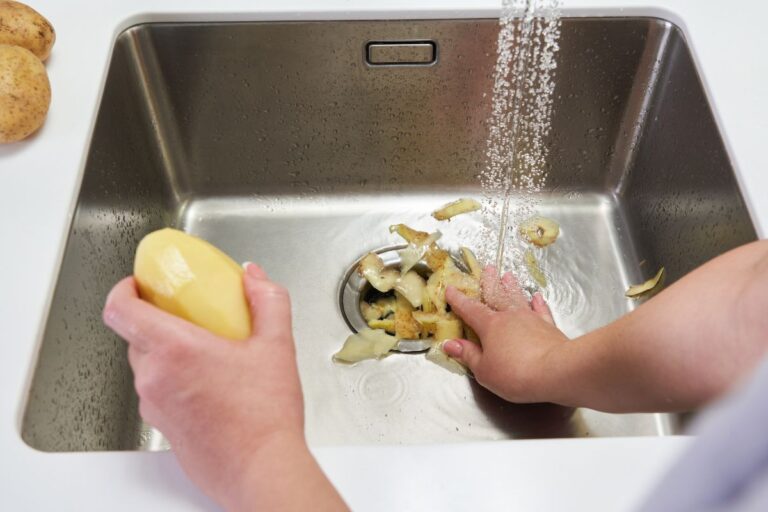In the realm of kitchen conveniences, the garbage disposal stands out as a modern-day marvel, a testament to human ingenuity in our unending quest for comfort and efficiency. However, it’s high time we debunk the myth of the disposal unit as an all-consuming, indestructible vortex where kitchen waste meets its end. Through personal mishaps and discussions with plumbing experts, I’ve come to understand that this appliance, like any other, has its limits and quirks. So before you consider your disposal unit a culinary black hole, let’s dive into the ten cardinal sins of garbage disposal etiquette, blending personal anecdotes with expert insights.
10 Foods You Should Never Put Down Your Garbage Disposal
1. Bones and Shells
Let’s kick this off with a classic no-no: bones and shells. My first, and quite memorable, encounter with this rule involved a Thanksgiving turkey carcass and a disposal unit that met its match. Bones and shells are simply too hard for the disposal blades to grind down, leading to a cacophony of unsettling noises and, inevitably, a jam. Plumbers agree, noting that bones and shells can blunt the blades, leading to costly repairs.
💡 Tip: If you find yourself with bones and shells that need disposing of, consider composting them or using them for stock before discarding them in the trash. It’s not just about protecting your disposal; it’s about making the most of your food.
2. Celery
Celery, with its fibrous, stringy texture, might seem innocuous enough, but it’s a disposal’s nightmare. I learned this the hard way when attempting to make a homemade vegetable broth. The strings from the celery wrapped themselves around the disposal’s blades like sinister vines, leading to a decrease in efficiency and a dreadful smell. Experts note that fibrous materials can entangle the disposal’s mechanisms, leading to blockages and motor burnout.
3. Coffee Grounds
Coffee grounds, the seemingly harmless byproduct of our sacred morning ritual, are deceiving in their disposal suitability. Initially, they appear to flow easily down the drain, but over time, they accumulate, creating a dense, sludgy sediment that clogs pipes. An acquaintance in the plumbing industry once shared images of pipes clogged with what looked like years of compacted coffee grounds — a sobering sight.
💡 Tip: Instead of sending them down the drain, add coffee grounds to your compost pile or use them as fertilizer for acid-loving plants.
4. Eggshells
Eggshells are a contentious topic in the realm of garbage disposal dos and don’ts. Many argue that grinding them helps sharpen the disposal’s blades, but this is a myth. In reality, the membrane lining of the shells can stick to the sides of the disposal, and the ground shells create a gritty paste when mixed with other wastes, leading to clogs.
5. Fruit Pits
Fruit pits, akin to bones, are far too hard for your disposal to handle. Whether it’s a peach, plum, or cherry pit, tossing it down your disposal is a gamble with the integrity of your appliance. The pits can become lodged between the blades and the housing, causing jams or even damage to the motor.
6. Grease
Grease is perhaps the most notorious culprit behind clogged pipes, yet it continues to find its way down our drains. Its liquid form at high temperatures is deceiving; as it cools, it solidifies, coating the pipes and trapping other food particles. The resulting blockages can be severe, requiring professional intervention.
7. Pasta
Pasta seems harmless enough, but it has a unique capacity for absorbing water and expanding, even after cooking. This can lead to blockages, as swollen pasta creates a gelatinous, sticky mass in your pipes. My own misadventure with a handful of spaghetti remnants served as a stark reminder of pasta’s deceptive nature.
8. Potato Peels
Potato peels, especially in large quantities, can spell disaster for your disposal. They contain starch, which becomes extremely sticky and can clump together, forming a mass that’s difficult for the disposal to process. This can lead to a clog that’s challenging to clear without professional help.
9. Rice
Much like pasta, rice expands in water, and it doesn’t stop growing once it’s gone down the drain. This capacity for expansion means that even small amounts can eventually lead to blockages, as the rice absorbs water and swells, filling the pipes. Yikes!
10. Stringy or Starchy Vegetables
The last category encompasses a broad range of offenders, from pumpkin to asparagus. These vegetables share a common trait: they’re tough on your disposal. Their fibrous, stringy nature can entangle the disposal’s blades, while their starch content contributes to the build-up of a thick, pipe-clogging paste.
💡 Tip: When dealing with these types of vegetables, composting is a viable and eco-friendly alternative to using your garbage disposal.
Conclusion
The garbage disposal is a wonderful tool, simplifying many aspects of kitchen clean-up, but it’s not invincible. Understanding and respecting its limitations is key to ensuring its longevity and avoiding unpleasant plumbing disasters. Personal experience, coupled with expert insights, has taught me that prevention is always better than cure. By keeping these ten items out of your disposal, you’re not just protecting an appliance; you’re safeguarding your home’s plumbing system, your wallet, and ultimately, your peace of mind.
Better Living uses affiliate links. If you make a purchase through them, we may receive a small commission (for which we are deeply grateful) at no cost to you.



